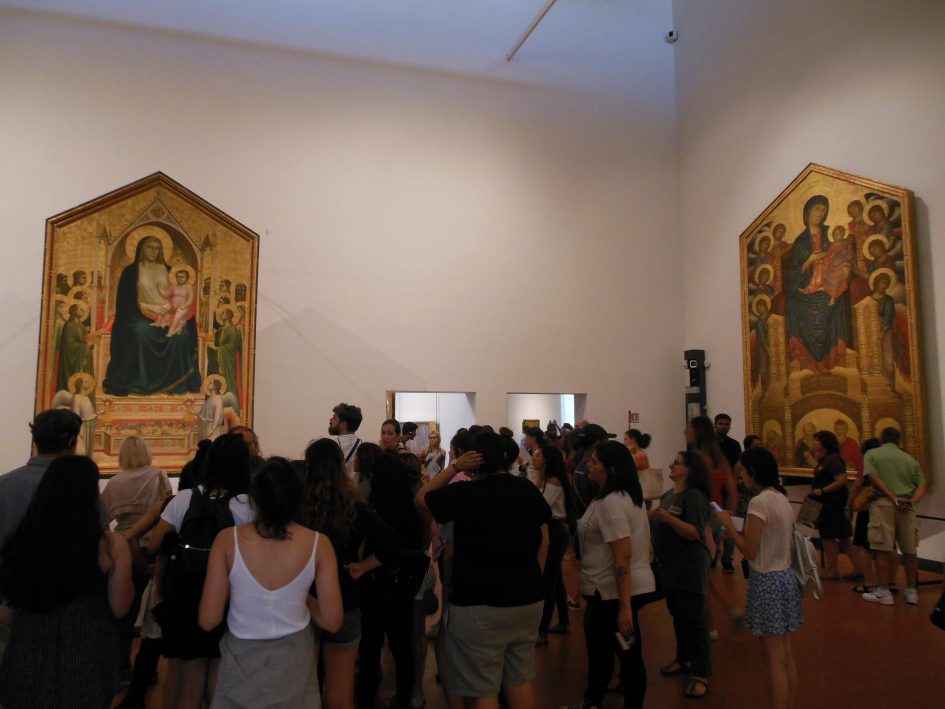1.1 Transitions: 14th Century Art in Europe
The 14th century (1300s) was a transitional time in European art and culture. During this period the medieval world begins to change and we see glimpses of Renaissance ideas in the visual arts by artists like Giotto and in literature by figures like Dante and Petrarch. Socially, one of the defining characteristics of the period was the Black Death, which struck Europe quickly in the middle of the 1300s–in part due to increased speed and volume of trade around the world–and resulted in the death of approximately one quarter of the population.
Optional: Smarthistory: The Black Death
Florence
Much of the cultural activity of the Renaissance was centered in Florence, a city-state in Tuscany on the Italian peninsula that experienced tremendous urban and economic growth in the late medieval and Early Renaissance periods.
Smarthistory: Florence in the Late Gothic
The painters Cimabue (1240-1302) and Giotto (1266-1377) are excellent examples of the stylistic shift that happened in much of European painting from the medieval period to the Renaissance.
Smarthistory: Cimabue and Giotto
[transcript available via this link]
After watching this video’s close reading of these two paintings, what specific elements make Giotto’s appear more “real”? Try to break apart the composition in order to articulate this. What are some of the reasons given for this stylistic shift?
Both of these paintings are altarpieces, large artworks that serve as a focal point within the liturgy (ceremony inside the church) and other public processions. One of the most famous documentations of a procession of an altarpiece is on Duccio’s Maesta in Siena, another Tuscan city-state that was an artistic rival of Florence.
As you watch, note what functions the Maesta served. Think about its entire form as well as its role within the church and within Siena.
Returning to Florence, Giotto’s fame reached far beyond the altarpiece discussed above. Giorgio Vasari (1511-1574), a writer who many consider the first art historian, noticed these differences and said the following of the young Giotto’s abilities over his teacher:
It is said that Giotto, while working in his boyhood under Cimabue, once painted a fly on the nose of a figure that Cimabue himself had made, so true to nature that his master, returning to continue the work, set himself more than once to drive it away with his hand, thinking that it was real, before he perceived his mistake.
[text cited from Lives of the Artists]
Think of what Vasari (writing during the 1500s) is valuing in Giotto’s art. How do you see this physically in the details of the painting when comparing it to Cimabue? How does this set up a particular attitude towards the styles of the Middle Ages?
Giotto earned further accolades and won major commissions during his career. One of the most important was the Arena (Scrovegni) Chapel, painted using the fresco technique, which mixes pigment with plaster that adheres directly to the wall.
Smarthistory: Arena (Scrovegni Chapel)
What details in this series of frescoes remind you of the realism lauded by Vasari?
Small Scale Art
Large altarpieces and frescos in chapels weren’t the only significant forms of painting in the 14th century. Some of the most expensive and highly prized art objects of the period were illuminated manuscripts, handwritten books filled with illustrations of all kinds. Many of these illustrated pages featured representations of three-dimensional space that the art historian Erwin Panofsky argued paved the way for Renaissance perspective.
One of the most intriguing books of hours is Jean Pucelle’s Hours of Jeanne d’Evreaux, Queen of France.
Met: Hours of Jeanne d’Evreaux
Flip through some of the pages of this book. What does this tell us about devotional practices of the late Middle Ages? How does the image relate to the text?
Devotional objects were not limited to books, of course. Private sculptures made for prayer were also common in the late medieval period. The German Vesperbild (“prayer picture”) was to be a visual aid for prayer, much like icons are used in Byzantine art.
Zoom into the image in the link. What do you notice about the sculpture’s details and surface?
Summary Questions:
What shifts do you notice in religious art of the 14th century compared to some of the earlier medieval works you’ve seen?
How do artists depict stories and settings from the stories of Christianity and what is the desired effect for the viewer?
Outline for Class Notes
